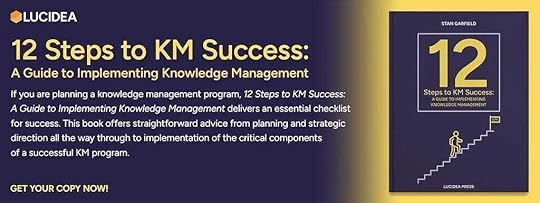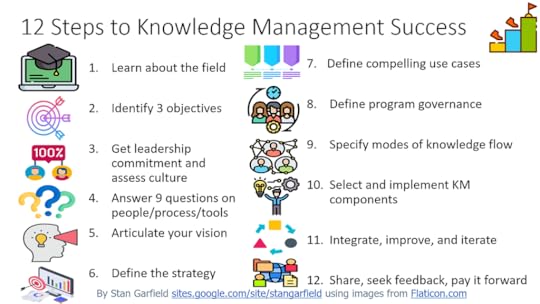12 Steps to KM Success: A Guide to Implementing Knowledge Management

This is my seventh book as sole author, and the fifth published by Lucidea Press. It has two dozen chapters. The first dozen are the 12 steps to follow in implementing knowledge management (KM). The second dozen consist of practical advice and in-depth recommendations.
Regardless of whether you are starting from scratch, taking over an existing program, or adjusting your current KM efforts, this book can help. When initiating a new program, try following the twelve steps, not necessarily in order but in whatever sequence makes the most sense. For existing initiatives, focus on the steps that may have been missed or that might not have been executed effectively.
Chapter 1 offers links to carefully curated lists of resources for learning, problem solving, and assistance. These provide a wealth of additional information for every stage of a KM program. Chapters 2–12 cover the rest of the twelve steps to success.
Chapters 13 through 24 contain useful insights, priorities, issues, lessons learned, knowledge nuggets, maxims, pitfalls to avoid, and proven practices. These are based on my 30 years as a practicing knowledge manager and can be applied to help make a KM program even more successful.
LinksBook Announcement: Ready to ReadDownload the free eBookOrder a hard copy from AmazonMy Other BooksMy KM Site
12 Steps to KM Success: A Guide to Implementing Knowledge Management is your comprehensive guide to programmatic implementation of successful KM components.
Successful knowledge management can improve internal communication, reduce duplication of effort, boost productivity, reduce risk from staff turnover, add value to client relationships, and deliver meaningful impact on competitiveness and profitability.
An effective KM program requires processes that facilitate knowledge sharing, capture, and reuse — and knowledge managers enable those key processes by implementing and integrating the right tools.
If you are considering initiating a knowledge management program, 12 Steps to KM Success: A Guide to Implementing Knowledge Management is an essential introduction to the subject area. A checklist for success, it offers straightforward advice from planning and strategic direction all the way through to program implementation of the components used to support successful KM.
 Table of ContentsIntroductionChapter 1: Learn About the FieldChapter 2: Identify 3 ObjectivesChapter 3: Get Leadership Commitment and Assess CultureChapter 4: Answer 9 Questions on People/Process/TechnologyChapter 5: Articulate Your VisionChapter 6: Define the KM StrategyChapter 7: Define Compelling Use CasesChapter 8: Define Program GovernanceChapter 9: Specify Modes of Knowledge FlowChapter 10: Select and Implement KM ComponentsChapter 11: Integrate, Innovate, and IterateChapter 12: Share, Seek Feedback, and Pay It ForwardChapter 13: 10 KM InsightsChapter 14: 10 KM Program PrioritiesChapter 15: 15 KM IssuesChapter 16: 10 KM Lessons LearnedChapter 17: 10 Knowledge NuggetsChapter 18: 36 KM MaximsChapter 19: 40 KM Pitfalls to AvoidChapter 20: Knowledge Sharing and ReuseChapter 21: How to Motivate Knowledge SharingChapter 22: How to Show the Value of KMChapter 23: How to Build Expertise in KMChapter 24: News of KM’s Death is Greatly ExaggeratedDedication
Table of ContentsIntroductionChapter 1: Learn About the FieldChapter 2: Identify 3 ObjectivesChapter 3: Get Leadership Commitment and Assess CultureChapter 4: Answer 9 Questions on People/Process/TechnologyChapter 5: Articulate Your VisionChapter 6: Define the KM StrategyChapter 7: Define Compelling Use CasesChapter 8: Define Program GovernanceChapter 9: Specify Modes of Knowledge FlowChapter 10: Select and Implement KM ComponentsChapter 11: Integrate, Innovate, and IterateChapter 12: Share, Seek Feedback, and Pay It ForwardChapter 13: 10 KM InsightsChapter 14: 10 KM Program PrioritiesChapter 15: 15 KM IssuesChapter 16: 10 KM Lessons LearnedChapter 17: 10 Knowledge NuggetsChapter 18: 36 KM MaximsChapter 19: 40 KM Pitfalls to AvoidChapter 20: Knowledge Sharing and ReuseChapter 21: How to Motivate Knowledge SharingChapter 22: How to Show the Value of KMChapter 23: How to Build Expertise in KMChapter 24: News of KM’s Death is Greatly ExaggeratedDedicationThis book about twelve steps is dedicated to twelve thought leaders: Chris Collison, Tom Davenport, Steve Denning, Nancy Dixon, Sue Hanley, Patrick Lambe, Nick Milton, Carla O’Dell, Kate Pugh, Dave Snowden, Tom Stewart, and David Weinberger. These KM visionaries were major influences on my thinking and development in the field of knowledge management. I am also fortunate to be able to call them my friends.
 Acknowledgements
AcknowledgementsI wish to thank Lucidea for their long-time support of my writing. I also greatly appreciate my editor, Sarah Nichols, for our ongoing collaboration.
BackgroundThis is my 30th year in field of knowledge management. In 1996, I was asked by the senior vice president of my business unit at Digital Equipment Corporation (DEC) to start a knowledge management program after we visited Ernst & Young’s Center for Business Knowledge in Cleveland, Ohio. When he heard that Ernst & Young had a Chief Knowledge Officer, he turned to me and said, “I want you to be our CKO.” This made it sound simple, but it turned out that a lot of time and effort were needed to get DEC’s KM program off the ground.
Along the way, I had to endure many ups and downs, enlist allies in the cause to join my virtual team, get executive sponsorship from a succession of leaders, increase investment and commitment to the program, deal with constant organizational change, adjust to changing technology, migrate from and integrate with legacy software, exercise diplomacy with many other groups, and cope with two large-scale corporate mergers.
Much of knowledge management has stayed the same during the past thirty years. The fundamental goals have not changed, the challenges are much the same, and the basic categories of people, process, and technology still apply. What has changed is the technology, the acceptance of KM as a strategic initiative, and the willingness of organizations to assign people to dedicated knowledge management roles.
We still struggle to get people to spend time sharing and reusing knowledge, it can still be hard to find information at the time of need, and expense budgets are still tight. But there are more people practicing KM today and there are powerful technologies that better address existing requirements and enable new capabilities.
The future challenges for knowledge management include creating new knowledge to stimulate innovation, expanding and better exploiting people networks, making it easier to find information when it is needed for better decision making, and effectively incorporating artificial intelligence (AI) by developing practical use cases. Knowledge management is here to stay, and by applying its fundamental concepts of learning from experience, reusing good ideas, and avoiding past mistakes, KM practitioners can ensure that their initiatives will succeed.

 [image error]
[image error]



